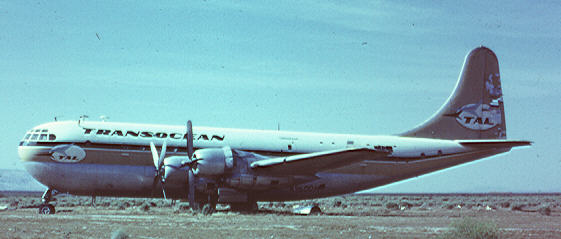Airliners In Detail #3: the Boeing 377 Stratocruiser

I was still in diapers when most airliner Stratocruisers
were retired, so needless to say, I haven't run across too many original
slides of them! The above image is the only slide I own of
an original non-altered Stratrocruiser. The fleet of Transocean Airlines
ended up in storage at Mojave for many years; this photo was taken there
in June 1968. (collection)
(Webmaster's note: Most of the information on this page was taken
from the excellent Peter Bowers article in the September 1999 issue of
Airpower.
This magazine is still available in back issue, and the article is highly
recommended--Andy)
The Boeing 377 Stratocruiser first flew on July 8, 1947 and entered
service with Pan American on April 1st, 1949. At the time of its
service introduction it was the largest, fastest, and most comfortable
of all the piston-engined airliners of the time. It was also a highly
complex and temperamental machine, and took a number of years of constant
refinement before becoming a truly reliable passenger airliner.
Introduction of pure jets spelled the end for most Stratocruiser passenger
service in 1960, but some continued flying throughout the 1960s as freighters.
In late 1960 Aero Spacelines acquired a number of Stratocruisers for conversion
to outsize cargo aircraft in the famous "Guppy" series. The
last unmodified airliner Stratocruiser, an ex-Northwest example, was scrapped
at Tuscon in the early 1990s.
Variant Briefing
Boeing 377-10-19: A single example was built and flown
as the Stratocruiser prototype. It was sold to Pan Am in 1950
and brought up to 377-10-26 standard.
Boeing 377-10-26: These were the twenty ordered by Pan
American. All were delivered with round passenger windows on both
decks and a rear galley.
Boeing 377-10-28: Originally ordered by SAS, but taken
up by BOAC, four in all. Like the Pan Am aircraft, they had round
windows on both decks and a rear galley.
Boeing 377-10-29: Eight were built for American Overseas Airlines.
These had round windows on the main deck, rectangular windows on the lower
deck, and a rear galley. Shortly after entering service with AOA
in 1949, the line was purchased by Pan Am, and these 8 aircraft finished
their passenger carrying careers with Pan Am in 1960.
Boeing 377-10-30: Ten were built for Northwest. They were
built with rectangular windows on the main deck and lower deck, and a rear
galley. All were retired by Northwest in 1959.
Boeing 377-10-32: Six were built for BOAC. They had round
windows on both decks, but a midships galley.
Boeing 377-10-34: Seven were built for United. These had
rectangular windows on the main deck, round windows on the lower deck,
and a midships galley. In 1954 the surviving United Stratocruiser
fleet was sold to BOAC.
Guppy variants: Rather than detail them here, I'll refer you
to the excellent All About
Guppys webpage. Data on all of the Stratocruiser-derived Guppies
can be found there, along with coverage of the CL-44 Guppy and the new
Airbus A300-600ST "Belugas".
Reference Photos
All of the reference photos here were taken by Gerald F. Cole.
The subject aircraft is the 377MG "Mini Guppy". While the fuselage
was significantly altered for the Guppy conversion,, the wings, nacelles,
and landing gear were not. Thus, the Mini Guppy is almost certainly
the last intact aircraft with true Stratocruiser airliner components.
Fuselage
Engines
and Wings
Landing
Gear
Available Model Kits
1/144th scale:
Minicraft
Stratocruiser/C-97
Otaki/Entex/Revell Super Guppy
1/72nd scale:
Academy
Stratocruiser
Back
to the Airliners In Detail Main Page
